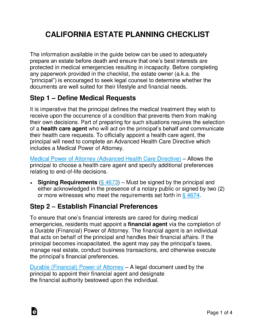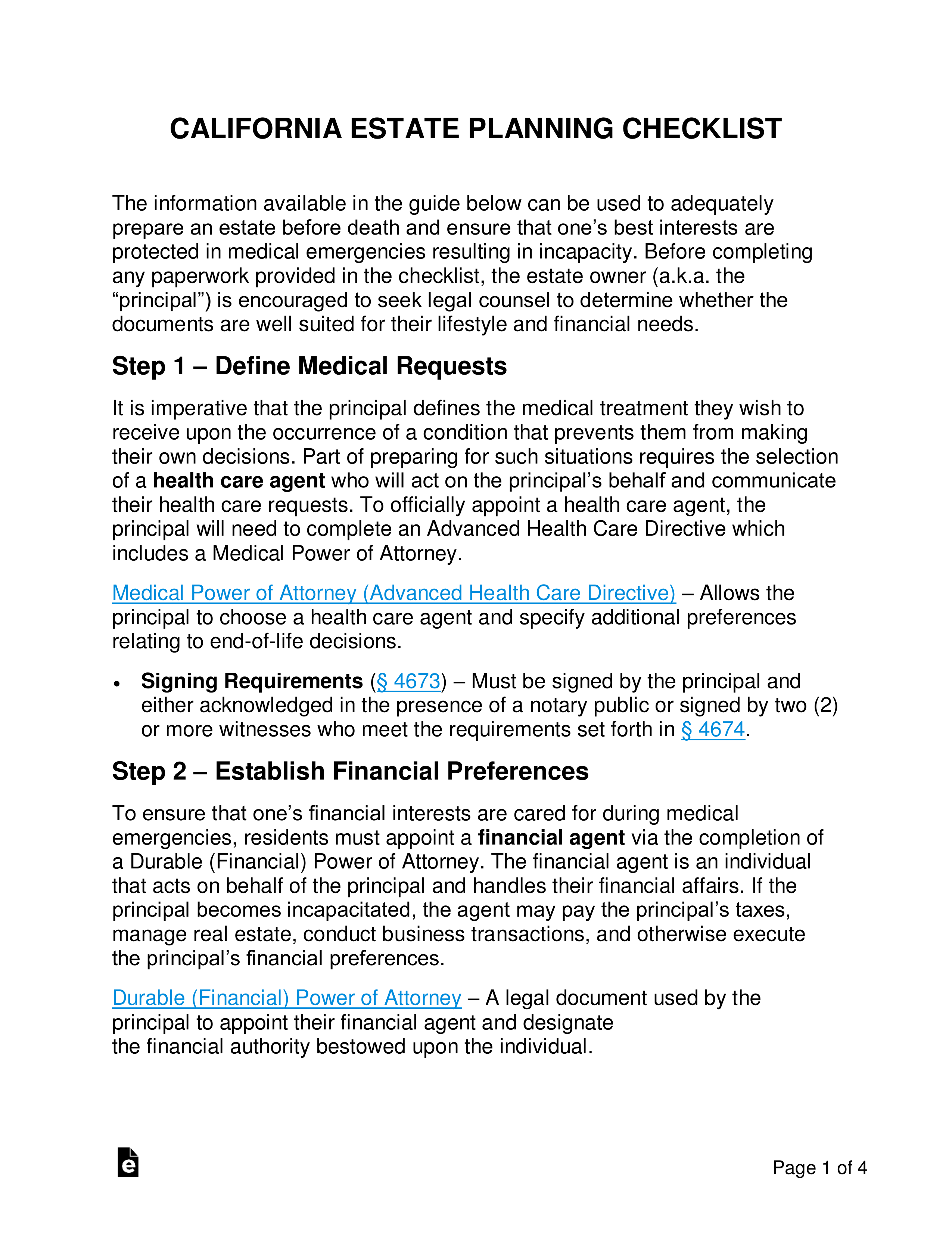Updated March 05, 2024
A California estate planning checklist is a set of instructions that can help individuals better prepare their estate for end-of-life scenarios while also ensuring the security of their well-being during medical emergencies. To protect one’s health and financial interests in the event of incapacitation, individuals will need to complete a Medical Power of Attorney (Advanced Health Care Directive) and a Durable (Financial) Power of Attorney. Another crucial aspect of estate preparation is the execution of a document that communicates one’s preferences regarding asset distribution. For this, individuals can draft a Last Will and Testament or a Revocable Living Trust.
How to Create an Estate Plan in California (6 steps)
- Define Medical Requests
- Establish Financial Preferences
- Describe Assets in the Estate
- Beneficiary Selection
- Draft an Estate Distribution Document
- Store the Estate Documents
The information available in the guide below can be used to adequately prepare an estate before death and ensure that one’s best interests are protected in medical emergencies resulting in incapacity. Before completing any paperwork provided in the checklist, the estate owner (a.k.a. the “principal”) is encouraged to seek legal counsel to determine whether the documents are well suited for their lifestyle and financial needs.
1. Define Medical Requests
It is imperative that the principal defines the medical treatment they wish to receive upon the occurrence of a condition that prevents them from making their own decisions. Part of preparing for such situations requires the selection of a health care agent who will act on the principal’s behalf and communicate their health care requests. To officially appoint a health care agent, the principal will need to complete an Advanced Health Care Directive which includes a Medical Power of Attorney.
Medical Power of Attorney (Advanced Health Care Directive) – Allows the principal to choose a health care agent and specify additional preferences relating to end-of-life decisions.
- Signing Requirements – Must be signed by the principal and either acknowledged in the presence of a notary public or signed by two (2) or more witnesses who meet the requirements.[1]
2. Establish Financial Preferences
To ensure that one’s financial interests are cared for during medical emergencies, residents must appoint a financial agent via the completion of a Durable (Financial) Power of Attorney. The financial agent is an individual that acts on behalf of the principal and handles their financial affairs. If the principal becomes incapacitated, the agent may pay the principal’s taxes, manage real estate, conduct business transactions, and otherwise execute the principal’s financial preferences.
Durable (Financial) Power of Attorney – A legal document used by the principal to appoint their financial agent and designate the financial authority bestowed upon the individual.
- Signing Requirements – The principal’s signature must either be acknowledged before a notary public or witnessed by two (2) or more individuals who meet the qualifications (if witnessed, the individuals must also sign the power of attorney).[2]
Financial Powers Allowed
- Real Property[3]
- Tangible Personal Property[4]
- Stocks and Bonds[5]
- Commodity and Options[6]
- Banking and Other Financial Institutions[7]
- Business Operating Transactions[8]
- Insurance and Annuity[9]
- Estate, Trust, and Other Beneficiary Transactions[10]
- Claims and Litigation[11]
- Personal and Family Maintenance[12]
- Benefits From Social Security, Medicare, Medicaid, or Other Governmental Programs, or Civil or Military Service[13]
- Retirement Plan Transactions[14]
- Tax matters[15]
3. Describe Assets in the Estate
4. Beneficiary Selection
5. Draft an Estate Distribution Document
After the principal’s assets have been itemized and the beneficiaries have been selected, it will be necessary to draft an estate distribution document that outlines how the assets will be handled following the principal’s death. This process can be accomplished through the execution of one (1) or both of the following documents:
Last Will and Testament (‘Will’) – A standard document that allows the principal to indicate the beneficiaries of their estate along with the assets each party will be given following the principal’s death. While a Last Will and Testament can be simple to create and requires no costs at its inception, the document will need to go through the probate court after the principal dies which can be a tedious process due to the additional costs and extended processing times.
- Signing Requirements – Signed by the principal and two (2) or more witnesses who were present either when the principal signed the Will, or when the principal acknowledged the signature or the Will itself.[16]
Living Trust (Revocable) – Creates an entity that holds ownership of the principal’s assets until they die or the document is terminated or revoked. During the lifetime of the principal, they can continue to manage the estate as if the assets were still in their possession. The principal will specify the beneficiaries and designate a trustee or successor trustee who will have permission to distribute the estate after the principal passes away. Unlike a Last Will and Testament, a Living Trust avoids the probate process and can therefore be administered immediately after death.
- Signing Requirements – Should be signed by the principal, two (2) adult witnesses, and acknowledged before a notary public.[17]
6. Store the Estate Documents
California Estate Planning Laws
- Medical Power of Attorney – Division 4.7, Part 2
- Durable (Financial) Power of Attorney – Division 4.5
- Last Will and Testament – Division 6, Part 1
- Revocable Living Trust – Division 9


